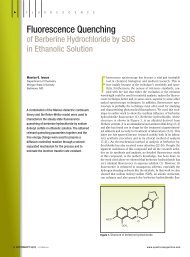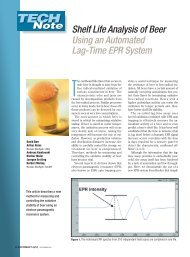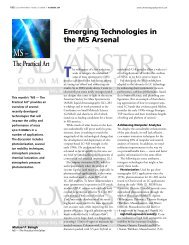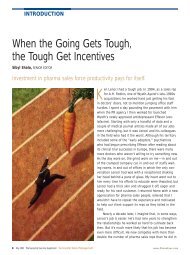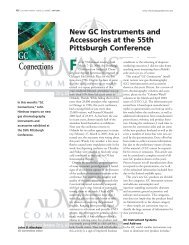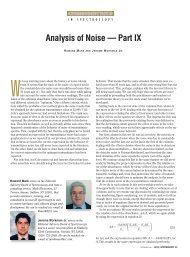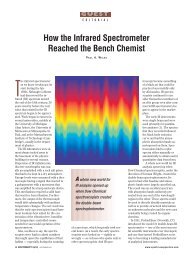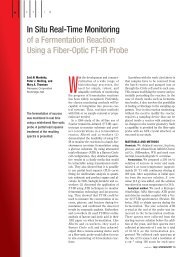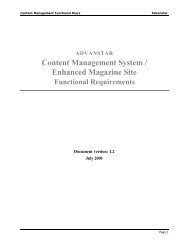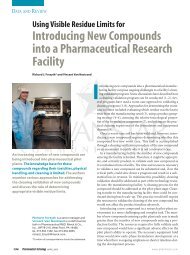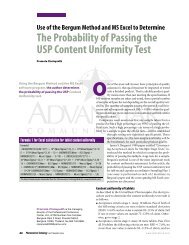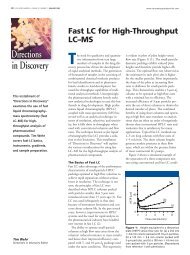Analysis of Noise â Part V - Spectroscopy
Analysis of Noise â Part V - Spectroscopy
Analysis of Noise â Part V - Spectroscopy
You also want an ePaper? Increase the reach of your titles
YUMPU automatically turns print PDFs into web optimized ePapers that Google loves.
...........................<br />
CHEMOMETRICS IN SPECTROSCOPY ............................<br />
mittance increases with T as and inversely with the reference<br />
energy.<br />
Here, however, under low-signal, high-noise conditions, where<br />
the variation <strong>of</strong> E r<br />
cannot be ignored and therefore the signal-tonoise<br />
ratio varies, we must use the full expression <strong>of</strong> equation 71.<br />
Note further that when E r<br />
is small enough, then, as mentioned earlier,<br />
the second term under the radical dominates, then:<br />
[72]<br />
Table II. Value <strong>of</strong> integral <strong>of</strong> (1/E r<br />
) 2 over the range 0.01 to<br />
0.01.<br />
Integration Interval<br />
Value <strong>of</strong> Integral<br />
10 2 2.0000000000000000e002<br />
10 3 3.0995354623330845e003<br />
10 4 3.2699678003698089e004<br />
10 5 3.2878691333625099e005<br />
10 6 3.2896681436917488e006<br />
10 7 3.2898481337470137e007<br />
The noise <strong>of</strong> the transmittance thus becomes directly proportional<br />
to T and inversely proportional to E r<br />
. Under these conditions<br />
the noise <strong>of</strong> the transmittance approaches infinite values as E r<br />
approaches<br />
zero, even as the expected value <strong>of</strong> the transmittance approaches<br />
zero, as we saw in the previous column(4).<br />
To summarize the effects at low signal-to-noise to compare with<br />
the high signal-to-noise case summarized earlier, here the noise <strong>of</strong><br />
the transmittance increases directly with T and still inversely with<br />
the reference energy.<br />
We now wish to follow through, as we did before, on finding the<br />
optimum value for sample transmittance under these conditions. To<br />
do this, we start with equation 24 (3):<br />
[24]<br />
This is the point at which, in the previous development, we considered<br />
the effect <strong>of</strong> letting E r become negligible, but <strong>of</strong> course in<br />
this case we wish to investigate the small-signal/large-noise behavior.<br />
We now, therefore, go directly to dividing A by A (from equation<br />
20b):<br />
[73]<br />
[74]<br />
[75]<br />
[76]<br />
To determine the variance <strong>of</strong> A/A we perform our usual exercise<br />
<strong>of</strong> taking the variance <strong>of</strong> both sides <strong>of</strong> equation 76 and applying<br />
our two favorite theorems; the result is:<br />
[77]<br />
We cannot simplify this equation further; in particular, we cannot<br />
separate out the variances <strong>of</strong> E s and E r to replace them with the<br />
same generic value. To determine the variance <strong>of</strong> A/A — that is,<br />
the relative precision (in chemist’s terms) — we need to evaluate<br />
the variance <strong>of</strong> the two terms in equation 77. As we observed previously,<br />
as the value <strong>of</strong> E r approaches E r , the value <strong>of</strong> the expressions<br />
attains infinite values. However, a difference here is that when<br />
the variance is computed these values are squared, and hence the<br />
computations are always done using positive values. This differs<br />
from our previous case, where the presence <strong>of</strong> both positive and<br />
negative values afforded the opportunity for cancellation <strong>of</strong> near-infinite<br />
contributions; we do not have that situation here. Therefore<br />
we are faced with the possibility that the variance will be infinite.<br />
An empirical test <strong>of</strong> this possibility was performed by computing<br />
values <strong>of</strong> the variance <strong>of</strong> the two terms in equation 77. The normal<br />
random number generator <strong>of</strong> MATLAB was used to create multiple<br />
values <strong>of</strong> normally distributed random numbers for E r and E s ; these<br />
were plugged into the two expressions <strong>of</strong> equation 77 and the variance<br />
was computed. Between 10 2 and 10 6 values were used in each<br />
computation <strong>of</strong> the variance.<br />
When E r was more than five standard deviations away from the<br />
center <strong>of</strong> the normal distribution representing E r , the computed<br />
variance was fairly small and reasonably stable, and decreased as E r<br />
was moved further away from the center <strong>of</strong> E r . This might be considered<br />
an empirical determination <strong>of</strong> the point <strong>of</strong> demarcation <strong>of</strong><br />
the “small-signal” case.<br />
When E r was moved below five standard deviations, the computed<br />
value <strong>of</strong> the variance became very unstable; computed values<br />
<strong>of</strong> the variance would differ by as much as four orders <strong>of</strong> magnitude.<br />
The closer E r came to E r , the more erratic the computed<br />
variance became. It was clear that bringing E r close to the center <strong>of</strong><br />
E r afforded more opportunity for a given reading <strong>of</strong> the noise to<br />
become close to E r<br />
, thus giving a value approaching infinity that<br />
would be included in the calculation. Furthermore, for a given relationship<br />
between E r<br />
and E r<br />
, the more readings that were included<br />
in the computation, the higher the values <strong>of</strong> variance that would be<br />
calculated. For example, with 100 readings, values <strong>of</strong> variance<br />
might fall between 10 1 and 10 4 while, with 10,000 readings, calculated<br />
variance values would fall in the range <strong>of</strong> approximately<br />
36 SPECTROSCOPY 16(4) APRIL 2001 www.spectroscopyonline.com



